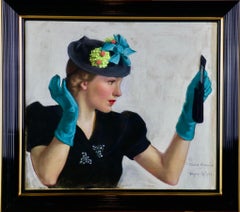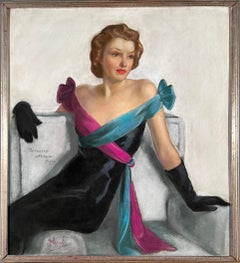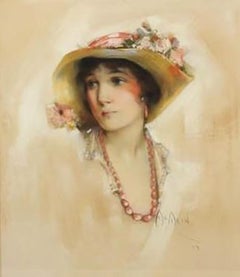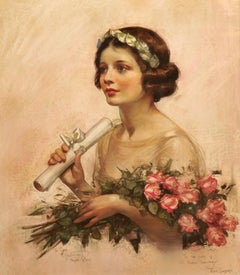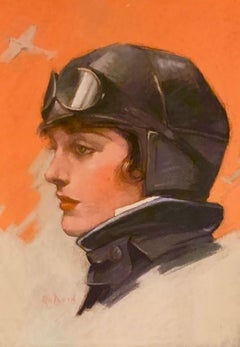Neysa McMein Art
to
5
4
4
1
2
2
1
Overall Height
to
Overall Width
to
1
5
4
4
2
2
2
2
2
2
1
1
1
5
1
1
2
6
6,874
3,208
2,516
1,217
4
4
1
1
1
Artist: Neysa McMein
"Looking Into the Mirror" Cover Illustration, Woman's Home Companion
By Neysa McMein
Located in Fort Washington, PA
Inscribed and Signed Lower Right "To / Olive Godwin / Neysa McMein"
"Looking Into the Mirror." Cover for Woman's Home Companion, published June 1938, with their stamp on verso. Past...
Category
1930s Neysa McMein Art
Materials
Pastel
"For Their Sakes - Work Together" Poster Maquette, NCCJ
By Neysa McMein
Located in Fort Washington, PA
Signed "McMein" Lower Right
"For Their Sakes - Work Together." Poster maquette for the National Conference of Christians and Jews, Brotherhood Week. T...
Category
Early 20th Century Neysa McMein Art
Materials
Oil
Saturday Evening Post Cover, Evening Gown May 21st, 1938
By Neysa McMein
Located in Miami, FL
Pastel on board - Saturday Evening Post Cover, Evening Gown May 21st, 1938 - Reproduced version looks better because the Saturday Evening Post Art Director retouched the plates before printing and strengthened the colors to give it more newsstand appeal - From Wiki : as an American illustrator and portrait painter who studied at The School of The Art Institute of Chicago and Art Students League of New York. She began her career as an illustrator and during World War I, she traveled across France entertaining military troops with Anita P...
Category
1930s American Impressionist Neysa McMein Art
Materials
Pastel
Associated Sunday Magazine Cover
By Neysa McMein
Located in Fort Washington, PA
Medium: Pastel on Board
Signature: Signed Lower Right
Sunday Magazine The Sun Cover, October 4, 1914.
Category
1910s Neysa McMein Art
Materials
Paper, Pastel
McCalls Magazine Cover
By Neysa McMein
Located in Fort Washington, PA
June 1925 McCalls magazine
'To the Girls of St. Agnes Seminary'
Neysa Moran McMein – later Mrs. John Baragwanath – wanted, as a girl in Quincy, Illinois, to be a musician. Although she changed her mind and attended the Art Institute of Chicago, she paid her way through school by writing music and playing piano in a ten-cent store.
During World War I, she went to France under the auspices of the YMCA, and entertained the troops with her singing and piano accompaniment to showings of Winsor McCay’s animated film “Gertie the Dinosaur”.
She painted her first McCall’s magazine cover in 1923, and for many years made pastel portraits of beautiful or notable young women for McCall’s monthly issues, as well as occasional covers for the Woman’s Home Companion, McClure’s, Photoplay, and The Saturday Evening Post. She also regularly contributed her drawings to the annual New York Times’ Hundred Neediest Cases.
McMein was equally noted as a hostess and friend of such notables as Alexander Woollcott, Irving Berlin, Marc Connolly, Ben Lillie, Irene Castle...
Category
1920s Other Art Style Neysa McMein Art
Materials
Pastel, Board
Related Items
Italian 18th Century Oval Religious Oil on Canvas Painting with Saint Dominic
By Francesco de Mura
Located in Firenze, IT
This beautiful Italian 18th Century old masters oil painting on oval canvas with giltwood frame is attributed to Solimena and features a religious scene.
In this splendid oval-shaped painting are depicted Saint Dominic...
Category
18th Century Old Masters Neysa McMein Art
Materials
Oil, Canvas
Fontana di Trevi
Located in Milano, MI
Urbex is the English acronym for urban exploration and is an activity that consists of searching for and locating abandoned infrastructure with the goal of visiting, photographing an...
Category
2010s Contemporary Neysa McMein Art
Materials
Sandstone, Stone
French Art Deco Society Portrait, Beauty in a Hat
Located in Cotignac, FR
A French art deco pastel portrait by Louis-Jean Beaupuy. The work is signed and dated bottom right. Presented in carved and gilded wood frame.
Beaupuy has captured all the charm and...
Category
Mid-20th Century Art Deco Neysa McMein Art
Materials
Paper, Crayon, Pastel
H 27.96 in W 21.66 in D 0.79 in
Venice Landscape Italian Oil on Canvas Painting in Gilt Wood Frame, Belle Epoque
Located in Firenze, IT
This delightful turn of the century (early 20th century) oil on canvas painting represents an Italian landscape with one of the most famous squares in the world: Piazza San Marco in ...
Category
Early 20th Century Impressionist Neysa McMein Art
Materials
Canvas, Oil
Venice Landscape Italian Oil on Canvas Painting in Gilt Wood Frame, Belle Epoque, Early 20th Century
H 51.19 in W 33.47 in D 1.19 in
Antique Dog Portrait of "Mignonne" dated 1876 by Louis Eugène Bourgeois
Located in SANTA FE, NM
Antique Dog Painting of "Mignonne" dated 1876
Louis Eugène Bourgeois (French 1831-1878)
Pastel on cardboard
Signed lower left "E. Bourgeois"
Inscribed upper right "Mignonne."
Rever...
Category
1870s Realist Neysa McMein Art
Materials
Pastel, Cardboard
Tribute to Michelangelo III by Zhang Hongyu - Contemporary portrait painting
By Zhang Hongyu
Located in Paris, FR
Tribute to Michelangelo III is a unique painting by contemporary artist Hongyu Zhang. The painting is made with Indian ink, pastel, acrylic, engraving and...
Category
2010s Contemporary Neysa McMein Art
Materials
Ink, Pastel, Acrylic, Cardboard, Engraving
Figure in a Wide-brimmed Red Hat
By René Gruau
Located in Miami, FL
Elegant and graphic study of a figure of undetermined gender. It's executed with quick and confident brush strokes in the artist's signature color scheme of black and red. It's a fla...
Category
1960s Contemporary Neysa McMein Art
Materials
Mixed Media, Pastel, Gouache, Board
Rare Modernist Hungarian Rabbi Pastel Drawing Gouache Painting Judaica Art Deco
By Hugó Scheiber
Located in Surfside, FL
Rabbi in the synagogue at prayer wearing tallit and tefillin.
Hugó Scheiber (born 29 September 1873 in Budapest – died there 7 March 1950) was a Hungarian modernist painter.
Hugo Scheiber was brought from Budapest to Vienna at the age of eight where his father worked as a sign painter for the Prater Theater. At fifteen, he returned with his family to Budapest and began working during the day to help support them and attending painting classes at the School of Design in the evening, where Henrik Papp was one of his teachers. He completed his studies in 1900. His work was at first in a post-Impressionistic style but from 1910 onward showed his increasing interest in German Expressionism and Futurism. This made it of little interest to the conservative Hungarian art establishment.
However, in 1915 he met the great Italian avant-gardist Filippo Tommaso Marinetti and the two painters became close friends. Marinetti invited him to join the Futurist Movement. The uniquely modernist style that he developed was, however, closer to German Expressionism than to Futurism and eventually drifted toward an international art deco manner similar to Erté's. In 1919, he and his friend Béla Kádar held an exhibition at the Hevesy Salon in Vienna. It was a great success and at last caused the Budapest Art Museum to acquire some of Scheiber's drawings. Encouraged, Scheiber came back to live in Vienna in 1920.
A turning point in Scheiber's career came a year later, when Herwarth Walden, founder of Germany's leading avant-garde periodical, Der Sturm, and of the Sturm Gallery in Berlin, became interested in Scheiber's work. Scheiber moved to Berlin in 1922, and his paintings soon appeared regularly in Walden's magazine and elsewhere. Exhibitions of his work followed in London, Rome, La Paz, and New York.
Scheiber's move to Germany coincided with a significant exodus of Hungarian artists to Berlin, including Laszlo Moholy-Nagy and Sandor Bortnyik. There had been a major split in ideology among the Hungarian avant-garde. The Constructivist and leader of the Hungarian avantgarde, Lajos Kassák (painted by Hugó Scheiber in 1930) believed that art should relate to all the needs of contemporary humankind. Thus he refused to compromise the purity of his style to reflect the demands of either the ruling class or socialists and communists. The other camp believed that an artist should be a figurehead for social and political change.
The fall out and factions that resulted from this politicisation resulted in most of the Hungarian avant gardists leaving Vienna for Berlin. Hungarian émigrés made up one of the largest minority groups in the German capital and the influx of their painters had a significant effect on Hungarian and international art. Another turning point of Scheiber's career came in 1926, with the New York exhibition of the Société Anonyme, organized by Katherine Dreier. Scheiber and other important avant garde artists from more than twenty-three countries were represented. In 1933, Scheiber was invited by Marinetti to participate in the great meeting of the Futurists held in Rome in late April 1933, Mostra Nazionale d’Arte Futurista where he was received with great enthusiasm. Gradually, the Hungarian artists began to return home, particularly with the rise of Nazism in Germany. Kádar went back from Berlin in about 1932 and Scheiber followed in 1934.
He was then at the peak of his powers and had a special flair in depicting café and cabaret life in vivid colors, sturdily abstracted forms and spontaneous brush strokes. Scheiber depicted cosmopolitan modern life using stylized shapes and expressive colors. His preferred subjects were cabaret and street scenes, jazz musicians, flappers, and a series of self-portraits (usually with a cigar). his principal media being gouache and oil. He was a member of the prestigious New Society of Artists (KUT—Képzőművészek Új Társasága)and seems to have weathered Hungary's post–World War II transition to state-communism without difficulty. He continued to be well regarded, eventually even receiving the posthumous honor of having one of his images used for a Russian Soviet postage stamp (see image above). Hugó Scheiber died in Budapest in 1950.
Paintings by Hugó Scheiber form part of permanent museum collections in Budapest (Hungarian National Museum), Pecs (Jannus Pannonius Museum), Vienna, New York, Bern and elsewhere. His work has also been shown in many important exhibitions, including:
"The Nell Walden Collection," Kunsthaus Zürich (1945)
"Collection of the Société Anonyme," Yale University Art Gallery, New Haven, Connecticut (1950)
"Hugó Scheiber: A Commemorative Exhibition," Hungarian National Museum, Budapest (1964)
"Ungarische Avantgarde," Galleria del Levante, Munich (1971)
"Paris-Berlin 1900-1930," Centre Georges Pompidou, Paris (1978)
"L’Art en Hongrie, 1905-1920," Musée d’Art et l’Industrie, Saint-Etienne (1980)
"Ungarische Avantgarde in der Weimarer Republik," Marburg (1986)
"Modernizmus," Eresz & Maklary Gallery, Budapest (2006)
"Hugó Scheiber & Béla Kádár," Galerie le Minotaure, Paris and Tel Aviv (2007)
Hugó Scheiber's paintings continue to be regularly sold at Sotheby's, Christie's, Gillen's Arts (London), Papillon Gallery (Los Angeles) and other auction houses.
He was included in the exhibition The Art Of Modern Hungary 1931 and other exhibitions along with Vilmos Novak Aba, Count Julius Batthyany, Pal Bor, Bela Buky, Denes Csanky, Istvan Csok, Bela Czobel, Peter Di Gabor, Bela Ivanyi Grunwald, Baron Ferenc Hatvany, Lipot Herman, Odon Marffy, C. Pal Molnar...
Category
Early 20th Century Modern Neysa McMein Art
Materials
Paper, Charcoal, Pastel, Watercolor, Gouache
Art Deco Portrait of a Young Blonde
By Franc Root McCreery
Located in Buffalo, NY
A beautiful pastel portrait by American female modern artist Franc Root McCreery
Franc Root McCreery
(1888-1957)
Born: Dodge City, Kansas, US
Franc Root M...
Category
1920s Art Deco Neysa McMein Art
Materials
Paper, Pastel
Pastel Portrait of a Circus Clown
By Samuel Brecher
Located in Hallowell, ME
Pastel Portrait of a Circus Clown
Samuel Brecher, American, (1897 - 1982)
This portrait of a clown is pastel on paper, is fully signed by Samuel Brecher and dated 1943.
This pastel painting of a clown measures 21.5 inches tall by 15.5 inches wide.
Matted in the frame the pastel portrait measures 33.5 inches tall by 26.5 inches wide.
Samuel Brecher was born in Boryslaw, Austria, a town near the Carpathian Mountains...
Category
1940s Neysa McMein Art
Materials
Paper, Pastel
"1940 - New Mexico Farmers" Orig. Mixed Media on Board by Tom Perkinson, Framed
By Tom Perkinson
Located in Encino, CA
"1940 - New Mexico Farmers" is an original mixed media on board by Tom Perkinson. His use of saturated violets, vivid yellows, and resplendent oranges pushes color to almost-otherwor...
Category
1970s Realist Neysa McMein Art
Materials
Pastel, Color Pencil, Watercolor, Mixed Media, Ink
No Reserve
H 18.625 in W 24.5 in D 2.5 in
Original 1920's/ 30's Portrait of Elegant Young Society Lady Exquisite Drawing
Located in Cirencester, Gloucestershire
Portrait of an Elegant Lady
original pencil drawing on paper
by Marjorie Schiele (1913-2008) *see notes below
signed
piece of paper is 12 x 9.5 inches
In good condition, though with ...
Category
Early 20th Century American Impressionist Neysa McMein Art
Materials
Crayon, Pencil
Previously Available Items
Saturday Evening Post Cover August 11th, 1917
By Neysa McMein
Located in Fort Washington, PA
Signature: Signed Lower Left
Category
1910s Neysa McMein Art
Materials
Pastel
Neysa Mcmein art for sale on 1stDibs.
Find a wide variety of authentic Neysa McMein art available for sale on 1stDibs. You can also browse by medium to find art by Neysa McMein in crayon, pastel, board and more. Much of the original work by this artist or collective was created during the 20th century and is mostly associated with the Impressionist style. Not every interior allows for large Neysa McMein art, so small editions measuring 19 inches across are available. Customers who are interested in this artist might also find the work of William Merritt Chase, Wilson Henry Irvine, and Henry Bacon. Neysa McMein art prices can differ depending upon medium, time period and other attributes. On 1stDibs, the price for these items starts at $2,400 and tops out at $175,000, while the average work can sell for $16,500.
